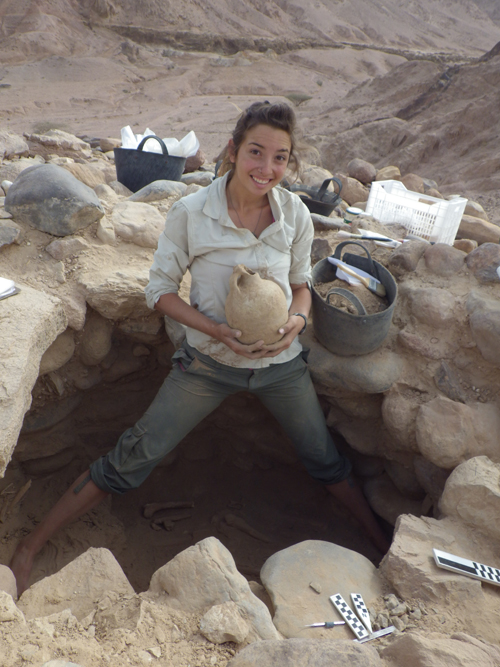Undergraduates Study Cultural Heritage During Summer Internships
San Diego, May 12, 2013 -- The Calit2 Center of Interdisciplinary Science for Art, Architecture and Archaeology (CISA3) and its NSF IGERT program in engineering for cultural heritage will provide exciting summer research opportunities through three programs.
|
Calit2 Summer Undergraduate Research Scholars Program
The Calit2 Scholars program kicks off in June, with two of the 30 Calit2 Scholars slated to work on CISA3 projects. Lillian Wakefield, who is studying environmental chemistry, will focus on the “Development of Analytical Methodologies for the Characterization of Lead White Pigments in Microsamples from Renaissance Paintings,” with Maurizio Seracini as her advisor. Separately, undergraduate Aliya Hoff will explore “Diagnostic Visualization Systems and Methodologies for Underwater Archaeology.” Hoff is interested in biological anthropology, and she will work with advisor Jules Jaffe at the Scripps Institution of Oceanography.
NGS-UCSD Engineers for Exploration
2013 is the inaugural year for a new summer program funded through a $380,000 NSF grant under its Research Experiences for Undergraduates (REU) program in the CISE directorate. The grant went to CSE professor Ryan Kastner, Calit2 research scientist Albert Yu-Min Lin and Calit2 wireless functional manager Curt Schurgers, who run the UCSD-National Geographic Engineers for Exploration program in Calit2. Engineers for Exploration is continually seeking new ways to break down barriers in the world of exploration with UC San Diego’s partners in the program, including National Geographic, Hubbs SeaWorld Research Institute, and San Diego Zoo Global. The eight undergrads in the inaugural class – some from UCSD, some from other institutions – will spend their summer in San Diego tackling real-world engineering challenges in exploration and scientific discovery.
As with the UCSD-National Geographic program, the REU grants will match upper-division undergrads to a variety of high-tech research projects overseen by scientists, engineers, and explorers from the university and program partners. “This NSF funding will allow us to expand the Engineers for Exploration program to invite enthusiastic engineering and computer science majors from across the U.S. to come to San Diego to design and test their own research projects in the field,” said PI Kastner. “The undergrads will benefit from the guidance of existing undergraduate leaders in the program, graduate students, professors, and scientific mentors from our partner institutes.”
Check back in January for information on applying for the summer 2014 program at http://bit.ly/Zjuez1.
CISA3 Undergraduate Research Internships
The CISA3 Undergraduate Research Internship (CURI) program offers academic credit to students interested in the interdisciplinary application of science and technology to cultural heritage diagnostics and preservation. The CURI internship is a four-unit independent study course listed as a choice of CSE 199 or Structural Engineering 199, which may serve as a technical elective towards the student's degree. Positions are available for all levels of experience, and each project will be crafted to suit and develop the student’s personal skill set. Current undergraduate research projects include:
• Digital archaeological illustration techniques and metadata recording applications;
• Educational outreach about archaeology and technology;
• Digital documentation (laser scanning, photogrammetry, structure from motion, GIS) of Balboa Park and Old Town;
• X-Ray Fluorescence and multispectral techniques for cultural heritage diagnostics of artwork and artifacts;
• 3D printing for cultural heritage analysis;
• Creating diagnostic point-cloud maps of mosaics for conservation;
• Design of cognitively ergonomic user interfaces for augmented reality and visualization in the immersive CAVE systems; efficient systems of visual and “tactile” navigation in virtual space; and
• Diagnostic imaging techniques and data capture methodologies for underwater archaeology; designing underwater panoramic stereo photography, structure from motion, and LiDAR.
|
On June 2, CURI intern Aliya Hoff is also set to present her research under Anthropology Prof. Margaret J. Schoeninger and Levantine Lab bioanthropology graduate student advisor Melanie Beasley on "Resurrecting the Iron Age Dead: A Case Study in Bioarchaeology." The talk is part of the UCSD Faculty Mentor Program Research Symposium, to be held at the Price Center.
Related Links
Calit2 Summer Undergraduate Research Scholars Program
UCSD-NGS Engineers for Exploration
Media Contacts
Doug Ramsey, 858-822-5825, dramsey@ucsd.edu


